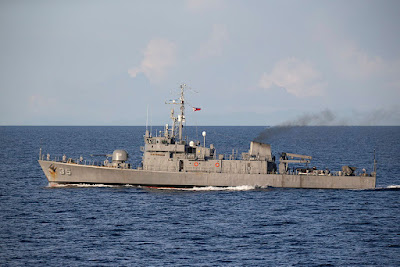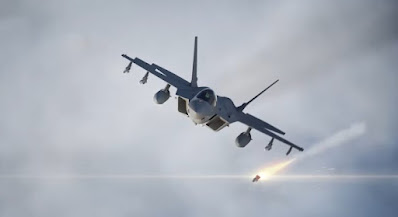Wednesday, October 13, 2021
HENSOLDT Develops Multifunctional Jammer to Counter New Threats
HENSOLDT’s ‘Kalaetron Attack’ – to be seen here in a pod version - combines latest technologies to secure control of the electromagnetic spectrum (image : Hensoldt)
Taufkirchen, Germany – Sensor solutions provider HENSOLDT has achieved a far-reaching technological leap in the advancement of technologies to control the electromagnetic spectrum. Combining artificial intelligence, digitisation, Active Electronically Scanning Array (AESA) and 3D printing technologies, HENSOLDT has developed a multi-function jamming system ('jammer') called 'Kalaetron Attack' that can actively jam enemy radars in an extremely wide frequency band, but can also be used passively as a reconnaissance sensor.
"The latest air defence and combat aircraft radars cover an extremely wide frequency bandwidth or jump between certain frequencies in a fraction of a second, making them extremely difficult to neutralise," says Celia Pelaz, chief strategy officer and head of the Spectrum Dominance division at HENSOLDT. "By combining the latest technologies, we have managed to optimise the emitted power in a targeted way while controlling the electromagnetic spectrum with one receive channel. This would make 'Kalaetron Attack' perfectly suited both as an aircraft self-protection system and in the role of an escort jammer."
Core elements of the system are a fully-digitised, broadband sensor and effector, a fully-polarisable, electronically controllable jammer and a condensed design of the electronic components only made possible by metallic 3D printing. This has made it possible to integrate the AESA jammer into a relatively small pod system that can be easily integrated into flying platforms but also scaled for sea and land applications. The next step in development is to fit it into an aircraft in order to confirm the already outstanding laboratory results in realistic flight tests.
‘Kalaetron Attack’ is part of HENSOLDT's all-digital ‘Kalaetron’ product family. It can be deployed in various configurations on diverse platforms for self-protection, ESM and signal intelligence tasks, depending on customer needs. HENSOLDT has been active in the spectrum dominance market for decades. The company has developed COMINT and ELINT sensors for NATO and partner forces and integrates them into EW systems for the Air Force, Army and Navy.
About HENSOLDT
HENSOLDT is a German defence industry champion with a leading market position in Europe and global reach. Headquartered in Taufkirchen near Munich, the company develops sensor solutions for defence and security applications. As a technology leader, HENSOLDT is also continuously expanding its portfolio in the field of cyber and developing new products to combat a wide range of threats based on innovative approaches to data management, robotics and cyber security. With more than 5,600 employees, HENSOLDT achieved a turnover of 1.2 billion euros in 2020. HENSOLDT is listed on the Frankfurt Stock Exchange, where it is part of the SDAX share index.
Malaysia Selects Radios from Rohde & Schwarz for Keris class
The Royal Malaysian Navy (RMN) is replacing the Chinese-supplied radios on its three Keris-class littoral mission ships (LMS) with those from German electronics manufacturer, Rohde & Schwarz.
Information published on the Malaysian finance ministry's procurement website indicate that the contracts are worth USD115,000 each. However, there are no details about which model was selected for the contracts.
BRP-Emilio Jacinto Departs Tawi-Tawi to Undergo Upgrade
COLONEL Romeo Racadio, Joint Task Force (JTF)-Tawi-Tawi, lauded the crew of the BRP-Emilio Jacinto (PS-35) for their hard work and dedication in securing the country’s waters in southern Philippines.“My gratitude to you for a job well done,” Racadio told the officers and men manning BRP-Emilio Jacinto.
Racadio led the send-off ceremony of BRP-Emilio Jacinto Friday, October 1, 2021, in Tawi-Tawi.The ceremony was highlighted with a ship tour and capability info brief facilitated by Commander Clyde Domingo, BRP-Emilio Jacinto commanding officer.Racadio then engaged with and presented a memento to the crew of the vessel.BRP-Emilio Jacinto is set to undergo repair and upgrade and will be replaced by BRP-Mariano Alvarez (PS-38).
BRP-Emilio Jacinto is currently assigned to the Offshore Combat Force of the Philippine Fleet.She is one of few ships in the Philippine Navy equipped with modern systems after the completion of combat, navigation, and weapon systems upgrades in 2019.“The BRP Emilio Jacinto has been of great help to the Western Mindanao Command (Westmincom) particularly in the campaign against terrorism and kidnap for ransom activity at sea,” said Major General Alfredo Rosario, Jr., Westmincom chief.
New video of the KF-21 Boramae, the future fighter developed in South Korea
The KF-21 Boramae is the new fighter aircraft jointly developed by South Korea and Indonesia, whose rollout took place on April 9 this year.
Its first flight is scheduled for 2022, but while we wait, the manufacturing company (KAI) released a promotional video in which, through computerized images, shows what the aircraft will look like and what mission profiles it will have.It should be remembered that, although it may not look like it, the KF-21 Boramae is an aircraft that in its present incarnation belongs to the 4.5 generation of fighters, similar to a Super Hornet or Rafale. It is a twin-engine with an expected top speed of 2,200 km/h, a range of 2,900 km and a combat load of up to 7.7 tons.
But it is a design intended from the outset to evolve. It will be produced in successive blocks, which will incorporate new capabilities, with more advanced materials and construction techniques, which will bring this aircraft to the same level as 5th generation aircraft such as the F-35 (considered the de facto standard in this category).
However, KAI recently announced that the KF-21 Boramae will evolve beyond the current 5 Gen fighters to incorporate features of the 6th generation fighters currently under development.
In the video, you can see one of these features being developed in different programs around the world, which KAI also plans to equip the Boramae with. It is the ability to work in a man-machine partnership with unmanned combat aircraft, or drones.
The images show the KF-21 leading a formation of 3 unmanned aerial combat systems, whose stealth design is reminiscent of Russian company Mikoyan’s Skat project.
The drones will be commanded by the KF-21 pilot, who will designate targets and other aspects relevant to the mission, acting as an important force multiplier. These operations will demand the use of powerful Artificial Intelligence (AI), both in the unmanned systems and in the KF-21, a disruptive technology that the 6th generation fighters have incorporated since their conception.





